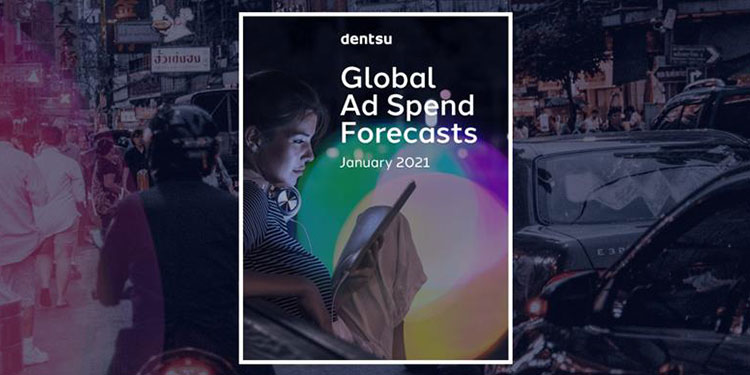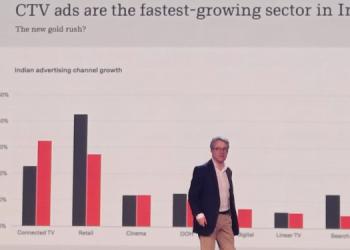dentsu recently released its 2021 forecast on Global Advertising Spend (Ad Spend). The report was based on data derived from 59 markets and predicts global ad spend growth of 5.8% in 2021, amounting to USD579 billion. Ad spend in Asia Pacific, home to 60% of the world’s population, is expected to grow by 5.9%, with share of digital forecast to increase 9.1% to a share of 57.5% of all spend.

“If the 2010s saw the rise of FOMO (Fear of Missing Out), the turn of the decade changed the feeling to FOGO (Fear of Going Out). Conspicuous consumption has been replaced by anxiety and sheltering, with many cautious about doing things that used to be ‘normal’, including shopping, using public transport, and being in crowded spaces. By the summer of 2020, one third of the world’s population had been in some form of lockdown, huddling close to the safety of our homes, as our lives shifted online, resulting in considerable increase in the use of at-home media such as Netflix, Zoom, and Twitch,” said Ashish Bhasin, CEO, dentsu APAC.
RISE OF SOCIAL COMMERCE
“Accelerated by the pandemic and enabled by 5G, technologies which were once thought to be tough to embrace became our key enablers: AI, collaboration tools and social-commerce adoption usage surged. Based on our recent ad spend report, we are expecting to see a dramatic increase in virtual products and experiences. Now that we are unrestrained by physical space, we are at liberty to reimagine what a concert, conference, shopping experience, buying property, cars, attending a class should and can be. As contactless technologies make stores less human, online commerce has become more social and more personal, marking the rise of Social Commerce, powered by next generation live streaming platforms,” added Bhasin.
DIGITAL SPEND LEADS IN APAC, STRONG GROWTH IN MOBILE-FIRST MARKETS
The pandemic has accelerated a clear shift to digital in terms of share of ad spend in 2020 versus 2019, with the region’s digital share of ad spend accounting for 55.7% share in 2020, higher than the global average of 48% and was the largest in terms of percentage across regions globally. The growth is led by China where digital spend in 2020 accounted for USD 64.7 billion (or 67% share of the market’s ad spend in 2020), up from 64.3% in 2019.
Digital ad spend in Hong Kong was up, accounting for 72.3%, a 9% increase from 2019. Digital spend in Singapore rose, at 39.8% share, up 14.4% from 2019. Japan’s digital spend also increased, at 47.3% share, up +7.1% from 2019. South Korea also showed significant growth with 55.1% digital ad spend, an increase by 11% versus 2019. India’s digital ad spend was at 27.9% share, an increase by 7.9 versus 2019. Indonesia’s digital ad spend was at 29.6%, increasing 5.5% versus the same time in 2019.
ONLINE VIDEO AND MOBILE
In 2020, online video in APAC saw growth of 4% and is forecasted to grow again by 3.9% in 2021. Some markets showed significant strides in spend in online video during 2020: India (46.2% in 2020) and is forecasted to grow an additional 45% over the next two years
Malaysia’s spend for Online Video jumped from USD61 million in 2019 to USD108 million in 2020, and Singapore from USD16 million in 2019 to USD62 million in 2020 – both indicating an incline for this medium in these two smaller, yet dynamic SEA markets.
Mobile-first markets, such as India and China, saw significant growth in mobile ad spend at 14.6% in China, during the period of 2019-2020. India showed strong momentum, at double the mobile ad spend in 2019-2020, growing 84% between 2019 and 2020; an increase of USD729 million in this period and is predicted to grow as the pandemic continues to keep people at home. Singapore also more than doubled the mobile ad spend to USD284 million in 2020, an increase of USD161 million from 2019. Vietnam’s mobile spend rose by almost half (+49.1%) in 2020 vs the previous year.
Based on a recent Brand EQ Trends Report released by dentsu’s Carat, the incline on digital ad spend will continue as people spend more time in their own homes as the pandemic continues into the 2020s. However, over time, there will be critical changes. There will be greater polarity in how people respond, based on age (with younger people being more willing to socialise again) and use of technology (amongst households with multiple connected devices, and better able to cope with isolation).
“People who have jobs based around using a screen will be able to work from home far more easily. As a result, many new consumer segments will emerge and brand marketers will need to work with their media and marketing agency partners even more closely, to tap into this opportunity. Brand marketers need to show a high level of empathy at these difficult times, to help customers and employees adjust as smoothly as possible,” Bhasin added.
TRADITIONAL MEDIA (TV, PRINT, OOH, CINEMA and RADIO)
There is still a market for traditional media, albeit a smaller share. In 2020, Television’s (TV) share of media was at a historical low of 28% across the APAC region, and is forecasted to continue declining into 2022. However, this varies significantly across this geography, with above regional average share in Southeast Asian markets: Vietnam (77%), Thailand (60.6%), Philippines (65%), Indonesia (56%) and also in India (41.1%), Japan (32.6%) and Taiwan (37%).
Ad spend for Print has declined in 2020, with Newspaper spend declining -26.9% in APAC. Magazines declined -32.9%. Out of Home In APAC declined by -15.9% but is forecasted to recover by 14.8% by 2022 when lockdowns are lifted.
Cinema was the worst hit globally in 2020 (-58.3%) but there appears to be significant confidence that people will rush back for the cinema experience by 2022, bringing with this an increase in ad spend from advertisers keen to get back in front of audiences. By 2022, globally cinema is set to bounce back by 64.7% but will likely take some time to fully recover. Recovery patterns will differ across markets and regions.
Globally, ad spend on Radio dipped by -10.1% versus the same time in 2019, with APAC figures dropping across the entire region by -21.6%. This is largely due to consumers shifting their media consumption to digital and social as the lockdowns continue.
Download the dentsu 2021 Ad Spend Forecast report HERE.
















